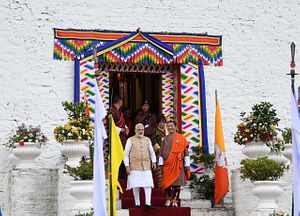Continuing India’s attempt to foster a strong relationship with its neighbors under the “Neighborhood First Policy,” Prime Minister Narendra Modi visited Bhutan for the second time on August 17-18. During the visit, Modi held a comprehensive discussion with Bhutanese Prime Minister Lotay Tshering and reviewed the current status of the bilateral relationship. The two countries also signed 10 Memorandums of Undertaking (MoUs) to further boost the ties, with Modi having said that “Bhutan has a special place in the heart of 130 crores [1.3 billion] Indians.”
India and Bhutan have a strong historical, cultural, and economic relationship. With the intent of infusing a strong bound of equality in the bilateral relationship, India under the UPA government decided in 2007 to amend the 1949 Treaty of Peace and Friendship, paving the way for Bhutan to act independently in foreign and defense affairs.
Coming to power in 2014, the BJP-led coalition under the leadership of Modi considered fostering ties with neighboring countries a major foreign policy priority. It was in this context that the prime minister of Bhutan, along with other heads of the South Asian Association for Regional Cooperation (SAARC) states, was invited for the swearing in ceremony of the Modi government. Subsequently, Modi decided to make his first foreign trip as prime minister to Bhutan – a move that surprised many strategic and foreign policy experts in Delhi. While Modi’s visit sent a clear signal about how important neighbors are for India, high-level political visits and exchanges between the two countries have since become a strong pillar of India-Bhutan ties. When the Modi government was voted back to power in May 2019, the heads of the BIMSTEC countries including Bhutan attended Modi’s oath-taking ceremony.
These political engagements and other developments have indeed heralded a new phase in the bilateral relationship between India and Bhutan in the last five years. The economic sector is an important aspect of this shift, with the two side trade having reached 92.28 billion Indian rupees ($1.2 billion) in 2018. Modi launched the RuPay Card to ease financial transitions between the two countries and he also said that an addition $100 million would be available to Bhutan under a stand by swap arrangement to meet the foreign exchange requirement.
New Delhi and Thimphu have also expanded cooperation in the energy sector. At a time when India is making efforts to expand the sources of its energy resources, Bhutan has the huge potential for developing hydropower. According to one estimate, around 30,000 MW of electricity can be generated by hydropower in Bhutan. However, as hydropower projects require huge investment, Bhutan needs the help of other countries in exploiting this form of energy. Consequently, the two countries signed an agreement covering cooperation in the hydropower sector in 2009, with the Indian government having committed to assist Bhutan in developing a minimum of 10,000 MW of hydropower by 2020 and import the surplus electricity. It is this context that during his visit, Modi inaugurated a 720 MW hydropower project on the Mangdechhu River. Consequently, India’s assistance has so far increased the hydropower generation capacity in Bhutan to 2000 MW, which is viewed as a strong symbol of win-win cooperation.
But, for Bhutan, economic dependency on India, the huge trade deficit, and hydropower have generated serious concerns in Bhutan about India’s real intentions. In fact, there are sections of experts and others who feel that India’s sole aim is to exploit Bhutan’s market and its natural resources for its benefits. Sadly, India has yet taken concrete efforts to address this range of concerns in Bhutan.
This was a prime reason for then-Bhutanese Prime Minister Jigme Yozer Thinley to meet Chinese Premier Wen Jiabao in Rio de Janeiro in June 2012. Though the meeting did not result in any concrete agreement, it underscored the rift between the two sides. However, the coming of the Tshering Tobgay government in 2013 and the Modi government in India in 2014 greatly helped in minimizing the role of China in adversely affecting the India-Bhutan bilateral. This became much more evident during the Doklam crisis between India and China in 2017, when Bhutan fully supported India’s stand, refusing to accept an offer of $10 billion from China as economic assistance. More to the point, India’s increased efforts to improve ties with Bhutan lies in the fact that any deal between Thimphu and Beijing on the Doklam issue will pose serious security challenges for India.
While Bhutan has been a time-tested friend for India, the sustained high-level engagement and other cooperative measures including the inauguration of the Ground Station built by the India Space Research Organisation (ISRO) that will enable Bhutan to use the South Asian Satellite for communication, disaster management and also tele-medicine, tele-education have significantly helped shaped the upward trajectory of the relationship. India should further take concrete efforts to address economic and other grievances on the part of Bhutan. It is only thereafter the relationship can touch a new height in the future.
Sumit Kumar is a fellow at the Maulana Abul Kalam Azad Institute of Asian Studies, Kolkata.

































